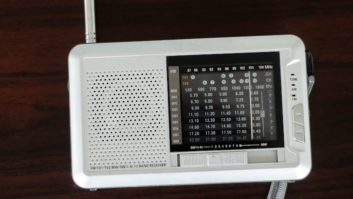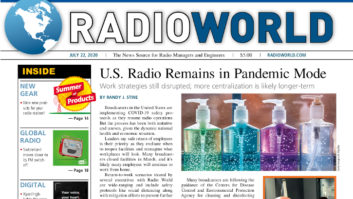The authors of this commentary are SVP, Broadcast Radio, and SVP, Engineering-Digital Platforms of Xperi, respectively.
When the COVID-19 pandemic was at its most critical early phase, consumers went to radio for local and accurate information.
During the recent protests? Radio was the choice for listeners in search of consistently useful updates.
After all, the internet and social media aren’t as effective at cutting through the noise and sharing relevant information; television is too broad, slow and methodical in its programming.
Though formats may have changed over time, the unique way radio delivers content makes radio a trusted friend in times of need.
According to Nielsen, eight out of 10 radio listeners were either listening to radio more or the same amount during the early part of the COVID-19 crisis — with 28% saying they were listening to radio more than usual and 60% of listeners reporting that they greatly respect and trust their local radio stations to provide late-breaking updates for their community.
And, some local radio stations saw huge upticks: KFI and KNX in Los Angeles were significantly up from earlier in the year, according to the Los Angeles Daily News in late May.
Radio has also proven adept at getting and keeping the attention of consumers. And, while radio is primarily an audio media, thanks to advances in digital broadcasting, broadcasters are now able to enhance their audio messages with text and visual information to create a complete information experience that reinforces each message for even greater engagement, with important ramifications for PSAs.
This convergence of digital technology with the audio format of radio has increased brand recall by up to 1,500% when compared to audio-only messaging, and, according to Xperi research, improves message recall. In one study, there’s a 12% lift among millennials:

All of which means greater opportunities to get public service messages out during the pandemic — and making them stick.
HD Radio PSAs: Essential Community Tools in a Crisis
At Xperi, we have a unique perspective on how radio is used during this crisis, and how HD Radio has been a game-changer. Broadcasters are frequently updating their listeners — from school and business closings to hot-spot surges and reminders on how to be safe and protect the most vulnerable.
With HD Radio, which is in over 65 million vehicles on the road in the United States, broadcasters are serving their communities by enhancing audio PSA messages about the virus with text and visuals to more easily get their attention and hold it, such as illustrations of the six-foot social distancing rule.
To understand the degree to which broadcasters used HD Radio metadata to convey information related to the virus — from hand-washing to social distancing — we conducted a snapshot analysis of Xperi data across 39 markets and 76 stations in Canada, the U.S. and Mexico between Feb. 15 and May 12, the height of the pandemic information rush:

When segmented across categories, this information appeared 1,810 times in news programs, 226 in news headlines, 445 in info URLs and 676 times in PSAs.
Among the reasons for this increase in use? Speed and ease of integration.
For example, Beasley Media Group quickly integrated messaging into an existing community program, and ran it across all 60 of their stations in very high rotation:


In Mexico, Grupo Formula created their own designs, including visuals for mask-wearing, stay-at-home, hand-washing and social distancing, for all their FM HD stations in major cities, including Mexico City, Guadalajara and Monterrey:

Other Mexico groups implementing PSA campaigns through HD Radio are Televisa Radio, Multimedios, Pergom and Grupo Oro. And Rogers Media in Canada is effectively using digital data fields in their HD Radio transmissions to convey news headlines and local community information.
During the most recent crisis, Beasley utilized enhanced PSA messaging on their QUU RDS systems, including a statement they shared on social media channels about their commitment to listeners and their families to promote positive change in the communities they serve and across our nation.
Digital Radio Key to Upgrading Emergency Alert Ecosystem
HD Radio Emergency Alerts are also invaluable community tools for broadcasters for emergency notifications.
The pandemic, and recent events around the protests, have reinforced the urgency of leveraging digital radio as an upgrade of the public alerting ecosystem — and our PSA data indicates that broadcasters are ready to implement it to better serve their communities.
A December 2018 report by the FCC’s Communications Security, Reliability and Interoperability Council (CSRIC) recommended upgrading several aspects, including, geographic targeting, multimedia, resiliency and redundancy, accessibility of alert information and integration of alerts across devices.
Digital radio technology — through HD Radio — can enable these improvements now. At Xperi, we believe it should be utilized as an integral part of the collaborative effort to upgrade the nation’s public alerting capabilities.
Proven Value Over 100 Years
Radio is simply the most efficient and flexible way to provide news and entertainment across geographic and topical segments, a claim the numbers support and remains the most consumed media channel, according to Nielsen Audio Today 2019 (total persons 12+).
So, it’s no surprise that it’s thrived for 100 years ( and why at Xperi, we are devoting a year-long campaign to celebrate the milestone).
During our recent unprecedented crises, it’s been radio — and digital radio — that has helped to deliver the information listeners have needed in the most comprehensive and convenient way. And when life returns to normal and priorities shift from social distancing to socializing, digital radio, and specifically, HD Radio, will help lead the way, providing a complete experience around the news and entertainment consumers want — when they want it — in a way that fits their lifestyle. It doesn’t take a crisis to see the value of that.
Comment on this or any story. Email [email protected] with “Letter to the Editor” in the subject field.







